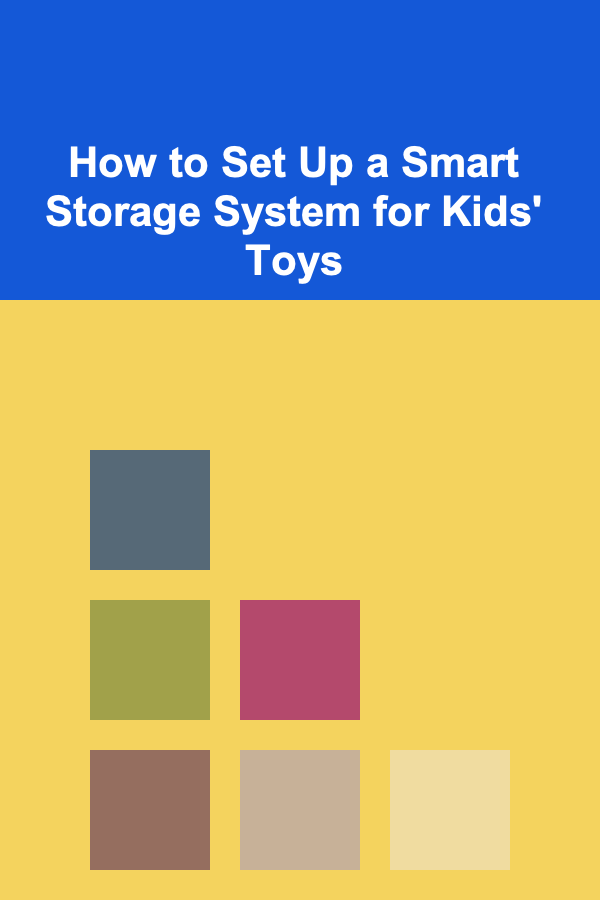
How to Set Up a Smart Storage System for Kids' Toys
ebook include PDF & Audio bundle (Micro Guide)
$12.99$10.99
Limited Time Offer! Order within the next:

Organizing kids' toys can often feel like an insurmountable task. As children grow, their interests change, and the number of toys they accumulate can quickly become overwhelming. A smart storage system not only helps keep the space tidy but also encourages children to take responsibility for their belongings. In this comprehensive guide, we will explore how to set up an effective toy storage system that is functional, appealing, and adaptable to your child's growing needs.
Understanding the Importance of Toy Organization
1.1 Benefits of Toy Organization
Organizing toys is more than just creating a visually appealing space; it has numerous benefits for both parents and children. Here are some key advantages:
- Fosters Responsibility: Teaching children to organize their toys instills a sense of responsibility and ownership.
- Encourages Play: An organized space makes it easier for kids to find and engage with their toys, leading to more productive playtime.
- Reduces Stress: A clutter-free environment reduces stress for parents and allows for smoother cleaning routines.
- Enhances Creativity: When toys are easy to access, children can use them more creatively without the barrier of disorganization.
1.2 Developmental Considerations
As children grow, their cognitive and physical abilities change. Understanding these developmental stages can help tailor the storage system to their needs.
- Toddlers: Require low bins and accessible shelving since they are still developing fine motor skills.
- Preschoolers: Can start to categorize toys but may need guidance in understanding where items belong.
- School-Aged Children: They can take on more responsibility and may benefit from a system that encourages independence, such as color-coded bins or labeled drawers.
Assessing Your Space
Before implementing a toy storage system, it's crucial to assess the available space. Here are some steps to evaluate your area:
2.1 Measure and Analyze
- Dimensions: Measure the dimensions of the play area or room designated for toy storage. Understanding the space will dictate what type of storage solutions will fit.
- Flow of Movement: Observe how your child interacts with the space. Is there enough room to play comfortably? Are there areas that often become cluttered?
- Lighting: Consider natural lighting. A well-lit area promotes creativity and engagement.
2.2 Identify Clutter Zones
Identify areas where toys tend to accumulate, such as corners, under beds, or in common living areas. This analysis will help you understand the most chaotic zones and how to tackle them effectively.
Choosing the Right Storage Solutions
The effectiveness of a toy storage system largely depends on the types of storage solutions you choose. Here are some factors to consider:
3.1 Types of Storage Units
- Baskets and Bins: These are versatile and can be used for various toy types. Look for options with handles for easy transport.
- Shelves: Open shelving units allow you to display toys while keeping them organized. Adjustable shelves can accommodate changing collections.
- Drawer Units: These are excellent for smaller toys. Choose units with clear drawers for visibility or label them for easy identification.
- Toy Chests: While they offer ample storage, ensure they're safe (e.g., slow-close hinges) to prevent accidents.
- Wall-Mounted Solutions: Utilize vertical space with wall-mounted racks or pegboards, ideal for displaying artwork or hanging lightweight toys.
3.2 Materials and Durability
When selecting storage solutions, consider the materials:
- Plastic: Lightweight and easy to clean, plastic bins are great for young children.
- Wood: Offers durability and aesthetic appeal but may require more upkeep.
- Fabric: Soft baskets are safe for toddlers but might require regular washing.
3.3 Consider Flexibility
Choose storage options that can adapt as your child grows. For example, a toy chest can transition from holding blocks to serving as blanket storage.
Categorizing Toys
Creating categories for toys can simplify storage and retrieval. Here's how to approach this process:
4.1 Common Categories
- Building Toys: LEGO sets, blocks, and construction kits.
- Art Supplies: Crayons, markers, paper, and craft materials.
- Action Figures/Dolls: Group by character type, series, or size.
- Outdoor Toys: Balls, bikes, and gardening tools.
- Books and Educational Toys: This section can include puzzles and games.
4.2 Implementing Subcategories
For larger categories, consider subcategories. For example, within building toys, you can separate LEGO sets from magnetic tiles or wooden blocks.
4.3 Encourage Rotation
Introduce the concept of toy rotation, where only a selection of toys is accessible at one time. This practice keeps the play area fresh and engaging while reducing clutter.
Creating a Toy Storage System
Once you've assessed your space and categorized the toys, it's time to create an efficient storage system.
5.1 Zoning the Play Area
Designate specific zones within the play area based on activity type. This zoning approach enhances organization and makes it easy for kids to locate their toys.
- Creative Zone: Art supplies and crafts.
- Play Zone: Building toys and action figures.
- Reading Nook: A cozy corner for books and storytelling.
5.2 Labeling and Accessibility
Labels play a crucial role in maintaining organization:
- Visual Labels: Use pictures alongside words for younger children who may not read yet.
- Color-Coding: Assign colors to different categories for quick identification.
- Easy Access: Ensure that frequently used toys are within reach, while less frequently played with items can be stored higher up.
Involving Kids in the Process
Involving children in organizing their toys fosters a sense of ownership and responsibility. Here's how to do it effectively:
6.1 Make it a Fun Activity
Turn organization into a game. Challenge them to see how quickly they can sort their toys or create a scavenger hunt for misplaced items.
6.2 Teach Responsibility
Explain the importance of taking care of their belongings. Encourage them to decide which toys they want to keep or donate, teaching them about generosity and sharing.
6.3 Set a Routine
Establish a daily or weekly routine for tidying up. Consistency will help children understand that maintaining organization is part of their responsibilities.
Maintaining the System
A successful toy storage system requires ongoing maintenance. Here are some tips to keep the system running smoothly:
7.1 Regular Assessments
Set aside time every few months to reassess the storage system. Are there toys that can be donated? Are there new toys that require additional storage solutions?
7.2 Seasonal Cleaning
Implement seasonal cleaning rituals, such as before birthdays or holidays. This practice can help manage incoming toys and prevent overflow.
7.3 Stay Adaptable
As your child grows, their interests will change, and so will their toys. Be willing to adapt the storage system to meet their evolving needs.
Conclusion
Creating a smart storage system for kids' toys is an investment in both your child's development and your home's organization. By understanding the importance of toy organization, assessing your space, choosing the right storage solutions, categorizing toys, and involving your children in the process, you can create a functional and appealing play area. Remember that the goal is not just to maintain a tidy space but also to foster a sense of responsibility and creativity in your child. With commitment and adaptability, you can enjoy a clutter-free home while encouraging your child's imaginative play.
Reading More From Our Other Websites
- [Personal Care Tips 101] How to Exfoliate Your Face After a Long Day
- [Personal Financial Planning 101] How to Invest in Sustainable and Ethical Companies
- [Personal Finance Management 101] How to Maximize Your Tax Refund Each Year
- [Home Storage Solution 101] How to Organize Your Linen Closet Like a Pro
- [Home Soundproofing 101] How to Soundproof a Utility Closet for Quieter Storage Spaces
- [Home Holiday Decoration 101] How to Use Fresh Flowers for Elegant Holiday Home Decor
- [Biking 101] Fixed Gear Bike vs. Single-Speed: What's the Difference and Which Is Right for You?
- [Simple Life Tip 101] The Best Minimalist Wardrobe Capsule for All‑Season Travel
- [Personal Investment 101] Best Small Business Investment Strategies for Millennials Just Starting Out
- [Home Pet Care 101] How to Keep Your Pet's Skin Healthy and Free from Irritations

Effective Tips for Saving on Taxes This Year: An Actionable Guide
Read More
How to Organize a Cleaning Challenge with Friends
Read More
How to Save Money on Your Home's Water Usage
Read More
How to Use Labels and Filters to Streamline Your Email
Read More
10 Tips for Nonprofit Event Planning on a Budget
Read More
10 Tips for a Sustainable Cleaning Schedule Planner
Read MoreOther Products

Effective Tips for Saving on Taxes This Year: An Actionable Guide
Read More
How to Organize a Cleaning Challenge with Friends
Read More
How to Save Money on Your Home's Water Usage
Read More
How to Use Labels and Filters to Streamline Your Email
Read More
10 Tips for Nonprofit Event Planning on a Budget
Read More